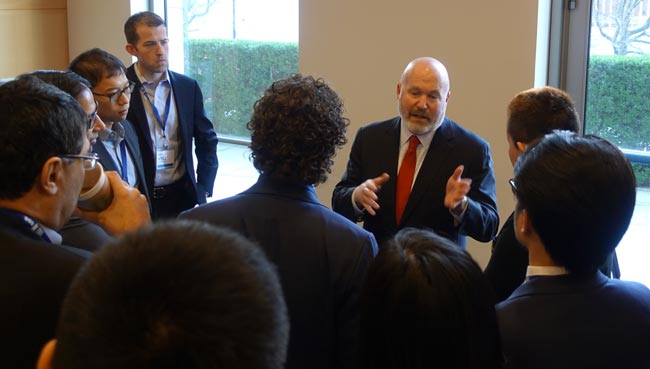Of all the people I've come across during the past few years, Clifford (“Cliff”) Asness is one of my favourite finds. In retrospective, I can’t understand how I did not already notice him ten or twenty years ago. He is a prolific writer.
I was lucky to meet Asness at a small conference in New York in late 2018. Anyone who has ever witnessed him in person will agree with what The New York Times wrote about him in 2005: “He was like an exuberant, well-dressed, overgrown kid, so overflowing with enthusiasms that he couldn't contain himself.”
I have been following (and enjoying!) his genius-level contributions to the investment media world ever since.
To help you understand why Asness is worth following, it’s useful to take a brief look at the past 35 years of his investment career.

Asness speaking to delegates at a students' conference in New York (author’s snapshot).
From academia to Goldman Sachs to hedge funds
Asness was an underperformer in school, reportedly preferring soccer to his studies. However, while at university, he discovered a passion for investment and portfolio management. His research into different investment strategies impressed Eugene Fama, a Nobel Prize laureate who is often thought of as the father of the efficient-market hypothesis. Asness not only worked as Fama's teaching assistant, but he also managed to sign him up as his mentor.
At the time, computer programmes to analyse markets and test financial theories were still in their infancy. Asness had learned how to code, and he dabbled with finding new ways for using technology to exploit weaknesses in the stock market.
For his PhD thesis, he explored "momentum investing", a strategy based on investors buying a stock for the simple reason that it is going up. Wildly popular during the 1990s, Asness initially thought momentum investing was a fool’s strategy. His research made him conclude, though, that it was a viable strategy, provided you are good at analysing the underlying data.
At the time, such quantitative research was mostly unheard of. Goldman Sachs didn’t even have a division for it yet, and Asness was asked to set it up. Wall Street’s #1 investment bank tasked him with finding ways to utilise university research findings – all ideas were considered!
Together with a few university colleagues, Asness created a computer model that combined traditional value investing with momentum investing. The computer would grab a massive amount of data to identify the cheapest value stocks and invest in these value stocks once they seemed to start an upward swing. Eventually, the computer also learned to apply the same model to growth stocks whose rise was stalling – which were then sold short. The idea was to create a perfectly balanced portfolio that would be market neutral, i.e. produce a return that was independent from the market going up or down.
Later, Asness’ team discovered that the strategy could also be applied to currencies, commodities, and entire economies. They started producing lists of “overvalued” versus “undervalued” countries.
Goldman Sachs handed USD 10m to the team of youngsters to manage. Their fund management skills proved so spectacularly good that within two years, they were managing USD 7bn on behalf of the firm and external clients.
In 1998, Asness resigned from Goldman Sachs and created his own firm – AQR, Applied Quantitative Research. Investors gave them USD 1bn to manage, which made it the biggest ever hedge fund start-up at the time.
Fast-forward to 2020, and AQR manages well over USD 150bn (!) in client assets across 41 funds. Asness himself is a billionaire, and his firm ranks among the most successful fund management companies in the history of money management.
Yet, he also has a blog “Cliff’s Perspectives”.
Here are some of the reasons why you might want to follow Asness' writing.
1. It’s authentically, passionately him
You are either a natural communicator and passionate writer, or you aren’t. If you are, then nothing will stop you from writing. It’s an urge to get the words out.
The New York Times once reported that one of the reasons why Asness quit Goldman Sachs was that the firm wasted his time on client meetings and presentations when all he wanted to focus on was research and writing.
Over the past decades, Asness has developed a long-standing reputation for not holding back. When he is in a foul mood over bad performance, he will smash up computers on his firm’s trading desk. He confirmed as much in his 2009 readers' letter to The Wall Street Journal: “Hey, those screens deserved it.”
Likewise, when something is bugging him, he will not hold back in written or spoken language.
Here is a guy who tells it as he sees it even if it gets him into trouble.
2. A blogger with 60 PhD-level experts backing up his work
Asness is basically running a think tank.
In his firm, 43% of all employees hold advanced degrees, and there are 60 PhDs on his team.
Reading Asness’ blog doesn’t just give you access to his brilliant mind, but also to the output of one of the world’s largest such teams of high-calibre thinkers.
Think about that – he shares all this with you for free!
They even try to make dry subject matters enjoyable. E.g., the most downloaded ever article that Asness contributed to asked when a hockey coach should pull the goalie when trailing – which was then connected to lessons in portfolio management, risk management, and business in general. “Pulling the Goalie: Hockey and Investment Implications” remains available for download.
FREE eBook: The world's best investing blogs
What are the best blogs to help you become a better investor and improve your returns?
Check out “The world’s best investing blogs” for my very own top 30.
3. Big ideas
I am always on the lookout for big ideas, which people like Asness tend to have a gut feeling for. At least that’s what I view as a significant part of their massive success. Get ONE big idea right and ride it for all it’s worth.
Asness' big idea right now?
The notion that value investing currently offers the largest opportunity ever in the history of the investment style.
Whereas so many others deem value investing to be “dead”, Asness bets the other way.
Granted, he’s been making that bet for quite a while already, and he has been wrong so far. Still, when someone like him pulls out all the stops to back one major investment theme, it’s worth paying attention.
4. Education
Many other large hedge funds barely ever speak to the media, let alone run a website for the wider public.
AQR, on the other hand, has a prominently displayed "Education" section on its corporate website.
This very section contains “Cliff’s Perspectives” - Asness’ blog. He writes irregularly and sometimes doesn’t post anything for half a year. But when he does post, expect articles that are as insightful as they are comprehensible.
In tune with the previous point, you could check out his May 2020 article: “Is (Systematic) Value Investing Dead?”
And if you prefer to watch Asness talk about this article rather than read it, you could watch his July 2020 webinar with Frank J. Fabozzi, editor-in-chief of the Journal of Portfolio Management. As Asness said during the 56-minute conversation: “Value has worked on average for 100 years, and will continue to work because it depends on human behavior, especially the tendency of people to "overreact" to market conditions regarding cheap and expensive stocks.”
When I saw him in New York, Asness was also a big believer of investing in European equity, because of the much more attractive valuations.
5. Twitter fun
Asness has 75,000 Twitter followers, and his account is one of the few that I check every now and again.
It’s an enjoyable mixture of insights into his personal life, fun (including sports and politics), and investment content.
One of the more memorable series of tweets involved a spat with the author of “Black Swan”, Nassim Nicholas Taleb, over the merits of spending money on insurance against extreme events.
As MarketWatch wrote at the time: “There’s nothing like a very public spat between two titans of the financial world.”(use this link to see the tweets of both sides)
Plenty of expletives were exchanged!
6. Public appearances
I like it when bloggers I follow make appearances in real life, whether that’s at conferences or through the likes of YouTube.
It makes their writing come alive if I have a chance to get a personal impression of them.
A piece some of my readers might enjoy is the following highly watchable interview.
Can you get a better mentor?
Asness got a great start in his career because Eugene Fama (and others) helped him develop his skills.
He now shares his knowledge through the Internet, undoubtedly quasi-mentoring a large number of people.
If you want to build on and improve your investment skills, then taking the occasional look at Asness’ views and insights is probably not the worst thing you could do.
You can also read a feature about him in the 2011 book “The Quants: How a New Breed of Math Whizzes Conquered Wall Street and Nearly Destroyed It”, which described him as “one of the smartest investors in the world”.
Insights from a self-made investment billionaire – readable, free, and guaranteed not influenced by advertising money.
Blog series: Blogs to watch
There's more to "Blogs to watch" than this Weekly Dispatch. Check out my other articles of this 30-part blog series.
Did you find this article useful and enjoyable? If you want to read my next articles right when they come out, please sign up to my email list.
Share this post:
Get ahead of the crowd with my investment ideas!
Become a Member (just USD 49 a year!) and unlock:
- 10 extensive research reports per year
- Archive with all past research reports
- Updates on previous research reports







